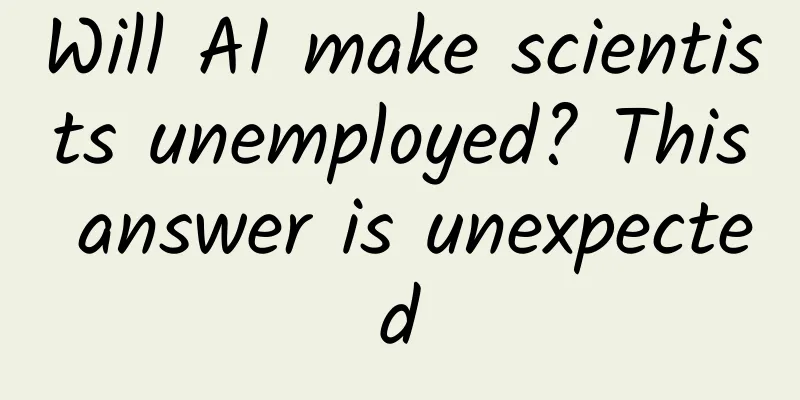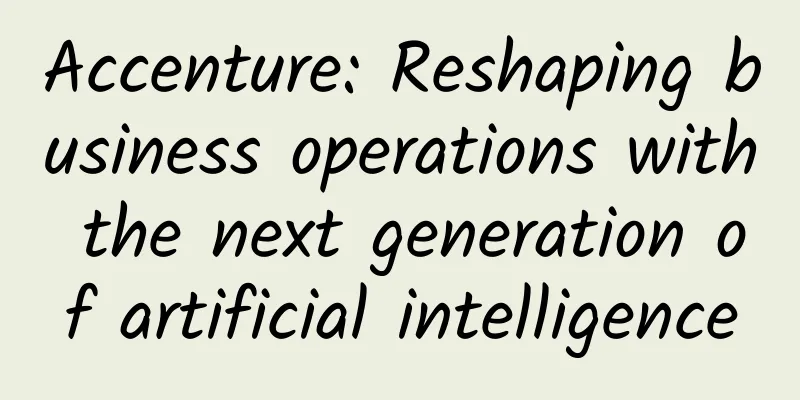Will AI make scientists unemployed? This answer is unexpected

|
The field of generative artificial intelligence is booming and there is a lot of discussion. Many people would express such feelings: if things continue like this, it is only a matter of time before they are replaced by AI. For example, there are many young scientific researchers, some of whom are engaged in biochemical, environmental and material research, and some of whom are engaged in computer science research. Some of them also joke from time to time: "It seems that scientists like me will probably be replaced by AI..." Does this really happen? This is indeed a very interesting question. First of all, it is certain that in the past 10 years, AI has also achieved "great results" in the field of science, and AI has frequently appeared in fields that seem to have nothing to do with AI. From protein structure prediction in the field of biochemistry to weather prediction in the field of meteorology, from medical image recognition to predicting and drawing odor maps of chemical molecules, AI can be seen everywhere. Generally speaking, the application of AI in scientific research mainly includes three aspects: the first is to use it as a tool to improve the work efficiency of scientists, the second is to participate in paper writing and review, and the third is to directly participate in scientific research. To answer the question "Will AI replace scientists?", we must first understand the current specific applications of AI in these three areas. Copyright images in the gallery. Reprinting and using them may lead to copyright disputes. AI-assisted enhancement Researcher work efficiency In 2023, Nature magazine conducted a survey of 1,600 scientists to understand researchers' usage and thoughts on generative AI. The results show that half of the participants are researchers in the field of AI. If this group of people is excluded, more than half of the researchers in non-AI fields will use AI in their scientific research. Researchers’ use of AI, Image source: Reference [1] In the eyes of researchers, the advantages of generative AI can be utilized in three directions: assisting non-native English-speaking authors in writing papers (including editing and translation), using AI to write code, and using AI to refine paper content to save reading time. Advantages of Generative AI (in scientific research), Image source: Reference 1 It is easy to understand that generative AI can help non-native English speakers write papers. It is indeed more "authentic" than many people whose native language is not English. And AI can adjust the expression of the article to be closer to the style of scientific research papers according to needs. AI coding can also greatly reduce researchers’ time. As long as clear requirements are given, large models such as GPT can generate code as required and explain the function of each piece of code. AI coding can not only help computer science researchers, but also non-computer science researchers who also have programming needs (such as doing bioinformatics analysis). AI coding can indeed greatly improve work efficiency, allowing researchers to spend their intelligence and time on things that they are better at and more important. Today, generative AI is already very good at extracting key information from summaries, and can extract more accurate information from specific modules of papers, such as "research methods" and "results and discussion" according to requirements. Therefore, using AI to "filter" papers can indeed save time. However, in these applications, AI does not directly participate in scientific research. It is more like a convenient dictionary or a handy screwdriver that can help researchers improve their work efficiency. The core work of scientific research is still done by scientists. AI participates in paper writing and review 1 AI writing papers Since the release of GPT 3.0 at the end of 2022, the content writing ability of generative AI has been widely recognized. And in some middle schools and universities, it is no longer a new topic for students to use generative AI to write homework and essays. But no school will encourage such behavior. After all, such "lazy" behavior is not conducive to students' thinking and growth. However, in a survey by Nature magazine, some researchers also mentioned that AI can be used to write paper manuscripts to save time, which involves the issue of "using AI to write papers." In fact, for young scientists, writing papers is a "basic skill" job. For some research fields that do not require experiments, searching for information and writing papers almost occupy the vast majority of scientific research. If AI can write papers, will the work of scientists in these fields be affected? It should be emphasized that the scientific community does not approve of the direct use of AI to write papers. First, we need to distinguish between two ways of writing a paper: "a human writes the first draft of the paper, and then AI adjusts the sentences and expressions" and "AI generates the first draft of the paper, and then humans optimize it." These two ways of writing a paper seem to be just reversed in order, but they are essentially two completely different things. When human scientists write the first draft, the analysis of the data and the discussion of the results are entirely carried out by human scientists. Even when writing a review paper, the integrated discussion and thinking of the content are also expressions of scientists' wisdom. Subsequent AI optimization is only the optimization of grammar and expression. AI is just a tool, not an author. However, if AI generates the manuscript first and humans make revisions, AI becomes the author. Although AI can produce text that "looks like that", it does not have "scientists' thinking" when generating the content of the paper. It only generates text based on pre-trained content, and the conclusions it draws may be biased and unreasonable. What’s worse is that AI-written papers may contain some “inexplicable” errors . For example, AI may fabricate literature out of thin air. Researchers who abide by academic ethics will not have such problems when writing papers. And for someone who directly generates papers using GPT, it is very likely that they will not check the literature one by one. Submitting such papers is a pure waste of reviewers’ time. At present, many journal companies have explicitly banned AI from being used as an author of papers. For example, Nature and Science. Well-known academic journal publishing companies such as Elsevier and Springer have issued statements prohibiting the use of "AI authors". For other places where AI is used in the paper, the method of use and the AI model version must be indicated. At the same time, AI-generated images are generally not allowed to be published (exceptions can be made in special circumstances with the permission of the editor). Because AI drawings are not an accurate reproduction of reality. This is not a serious problem in the field of artistic creation, but the pictures in scientific research papers must be true and rigorous, so AI-generated pictures are not allowed. For example, the "AI mouse" picture that caused a sensation in the academic community some time ago was seriously inconsistent with scientific facts and was therefore retracted. Images generated using Midjourney in the retracted paper Of course, the academic journal field is not absolutely exclusive of AI technology. For example, Elsevier’s statement mentioned that AI technology can be used to improve the readability of papers and optimize language expression. And when using basic AI tools to check spelling, grammar and references, no special instructions are required. Therefore, when it comes to writing scientific papers, AI will not replace human scientists, but it can improve the efficiency of scientists in writing papers. 2 AI participates in paper review In the field of scientific papers, there is another problem that gives researchers a headache - peer review. In addition to their own research work, researchers also need to review peer research papers. As the number of research papers increases, researchers need to spend more and more time on peer review. Now, AI tools are beginning to emerge in this field to help scientists reduce their burden. For example, the Penelope.ai tool can check the manuscript structure and reference format; StatReviewer can be used to test the reliability of data and statistical methods. In addition, a tool called UNSILO can extract the summary of the paper to facilitate the review by human scientists. Some researchers directly use AI such as Chat-GPT to generate peer review content. As for the question of AI's participation in peer review, how much and how AI can participate remains to be discussed. But what is certain is that at present, the review of most journal papers still needs to be completed by human scientists. The National Institutes of Health (NIH) and the Australian Research Council (ARC) have both issued statements prohibiting researchers from using AI to generate peer review content. This is because the review of scientific research papers involves professional knowledge, and the papers may contain sensitive data, which may be uploaded to Chat-GPT and pose a risk of data leakage. AI directly involved in scientific research related work What I have mentioned above are all cases where AI is used as an auxiliary tool in scientific research. In some fields, AI may really play a role no less than that of human scientists. In fact, AI has already shined in these fields long before the rise of generative AI. 1 As a prediction model AlphaFold, a protein three-dimensional structure prediction program developed by DeepMind, is a typical example. For a long time, studying the structure of proteins has been an important but difficult task, because the three-dimensional structure of proteins determines their functions. However, in the past 60 years, humans have observed a total of 170,000 protein structures, which is less than 1% of the total number of proteins in nature. Proteins are formed by folding amino acid sequences, and scientists have tried to find the relationship between amino acid sequences and protein structures. But this is not easy, because there are too many possibilities for amino acid chains to fold. If a computer is used to traverse all possible structures and find the most stable one, it will take an astronomical amount of time. This problem is very similar to the problem that AI has to solve when playing Go. Therefore, DeepMind, the company that created the famous Go robots AlphaGo and AlphaZero, used 170,000 known protein data to create the AlphaFold model. In 2018, AlphaFold's accuracy in predicting protein structures exceeded that of the top human scientific research teams. During the COVID-19 pandemic, AlphaFold 2 also participated in the structural prediction of the coronavirus spike protein and shared the results. Of course, AI can also be used in other predictive models. For example, in 2023, Google used AI to map the odors of 500,000 chemical molecules to help humans understand the relationship between chemical molecules and smell. And based on such maps, scientists can synthesize corresponding chemicals according to the target odor. In the field of weather forecasting, AI models also perform well. For example, the weather forecasting model GraphCast can predict global weather for the next 10 days within 1 minute, and the prediction accuracy is higher than that of traditional models, and the cost is lower. 2 As an important processing tool In addition, AI's ability to analyze and process data can also help human scientists conduct better research. Through training, AI can remove noise data from large amounts of data, allowing researchers to obtain more reliable information. Take astronomy research as an example. When taking photos of the starry sky, astronomical telescopes on the ground will be disturbed by the atmosphere. In the past, in order to eliminate the interference of the atmosphere, people needed to launch telescopes into space, such as the Hubble telescope and the Webb telescope. By using AI tools, scientists can optimize images taken by ground-based telescopes and eliminate interference from the atmosphere. Moreover, AI models using deep learning have a higher optimization effect than traditional methods. The photos taken by the ground-based telescope are gradually de-noised (the upper left is the original image, the lower right is the processed image). Image source: Reference [7] In addition, in 2019, scientists released a photo of a black hole, which attracted worldwide attention. At that time, everyone saw the image on the left in the picture below. In 2023, with the help of the AI model PRIMO, scientists optimized this image to the image on the right in the picture below. The black hole photo released in 2019 (left) and after being processed by PRIMO (right). Image source, reference [8] Such higher-resolution images can help scientists more accurately estimate the mass, size, and rate of matter consumption of a black hole. Of course, in addition to image denoising, AI’s data processing capabilities can also be applied to other types of data. It can be said that with the help of AI tools, scientists can indeed get more and better results, which is very valuable for scientific researchers. discuss From the previous applications, we can see that in the field of scientific research, human scientists still play an irreplaceable role . From the proposal of scientific research ideas, to the design of experimental methods, to conducting experiments and analyzing data, the wisdom of human scientists is needed. After the emergence of generative AI, although people can use it to help optimize text, grammar, and expression, the writing of papers and peer review still rely on human scientists. Even in cases like AI predicting protein models, the final observational verification still needs to be done by human scientists. And in these models, although AI can make predictions, the prediction process of AI is a "black box" and AI cannot explain why such predictions are made. The exploration of the mechanism of protein folding still needs to be completed by human scientists. But it is undeniable that with the help of AI, scientists have indeed improved their efficiency in solving problems. Scientists can focus more attention and time on higher-dimensional thinking. At present, there are still many scientific research fields that have not yet involved AI, but as Karim Lakhani, a professor at Harvard Business School, said, AI will not replace humans, but humans who use AI will replace humans who do not use AI. The same is true for scientific research work, of course. References [1] Van Noorden R, Perkel J M. AI and science: what 1,600 researchers think[J]. Nature, 2023, 621(7980): 672-675. [2] Kacena MA, Plotkin LI, Fehrenbacher J C. The use of artificial intelligence in writing scientific review articles[J]. Current Osteoporosis Reports, 2024: 1-7. [3] https://www.science.org/content/article/science-funding-agencies-say-no-using-ai-peer-review [4] https://www.science.org/content/article/ai-churns-out-lightning-fast-forecasts-good-weather-agencies [5] https://www.science.org/content/page/science-journals-editorial-policies?adobe_mc=MCMID%3D797307340825707067541028171796633734 64%7CMCORGID%3D242B6472541199F70A4C98A6%2540AdobeOrg%7CTS%3D1675352420#:~:text=In%20addition%2C%20a,s%20scientific%20misconduct [6] https://www.science.org/content/article/game-has-changed-ai-triumphs-solving-protein-structures [7] https://www.space.com/ai-software-unblurs-images-ground-based-telescopes[8]https://www.space.com/first-ever-black-hole-image-ai-makeover[9]https://hbr.org/2023/08/ai-wont-replace-humans-but-humans-with-ai-will-replace-humans-without-ai Planning and production Author: Tian Dawei, Master of Institute of Oceanology, Chinese Academy of Sciences Review丨Yu Yang, Head of Tencent Xuanwu Lab Planning丨Xu Lai Editor: Lin Lin The cover image and the images in this article are from the copyright library Reprinting may lead to copyright disputes |
<<: Cat meme video goes viral! What is the magic of this video for young people?
>>: The most nutritious way to cook soy products, have you tried it at home?
Recommend
You can pay even when you don’t have internet connection! The digital RMB App has been downloaded over 20 million times!
On January 17, according to Cailianshe, data from...
Zhihu brand promotion skills and cases
Doing brand promotion can increase your own visib...
Don't do this before going to bed! It hurts your body and your heart. You must have been "hit" before!
As the saying goes, there is no overnight hatred ...
Is Houttuynia cordata a "harmful grass" and does it contain a first-class carcinogen? The truth is...
Author: Wang Yanli, registered dietitian Reviewer...
Is the universe being torn apart? The culprit may be the empty vacuum!
Could the empty vacuum be the culprit behind the ...
Finally, it’s clear! Why is it so difficult to improve mobile phone batteries?
From a mini black and white screen with a few pix...
In 2020, is selling products the top priority for brand live streaming?
2019 is considered the first year of live streami...
Practical Tips | Teach you how to write a product experience report that will make HR scream (taking Baidu Maps as an example)
During the job search process, a complete product...
The “screenwriter’s mindset” for creating hit short videos
In 2020, the number of creators on the short vide...
The latest policy on village cadres in the Central Government’s No. 1 Document of 2022: Will all village cadres be abolished in 2022?
Recently, Xinhua News Agency authorized the relea...
It’s the “battery anxiety” again! How long can a mobile phone last with 1% battery?
In modern society Mobile phones have become part ...
Microsoft Office 2016 creates mobile office solutions for large and medium-sized enterprises!
Over the past few decades, Microsoft's Window...
Even Tencent has given in like this, so how powerful is Apple?
WeChat, the national app, has recently made headl...
Google bidding advertising account opening, Google account opening fee, Google advertising display
Google promotion is divided into Google bidding p...









